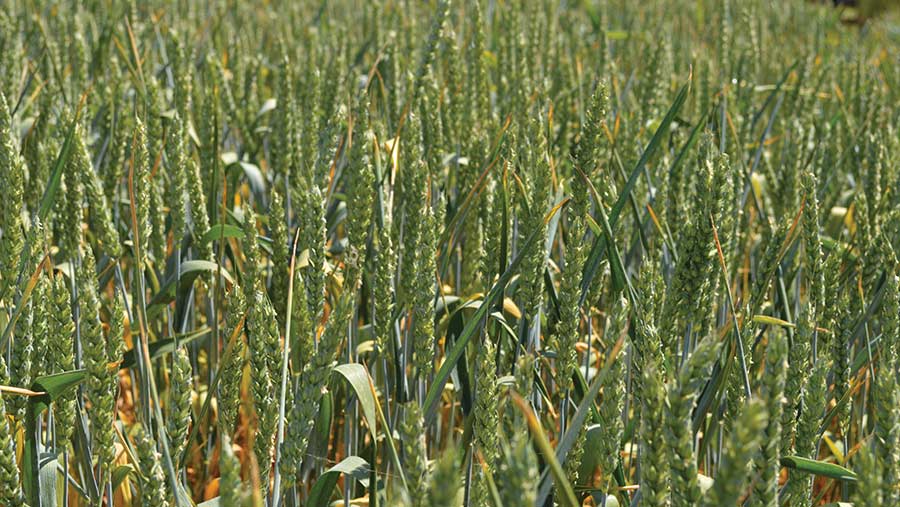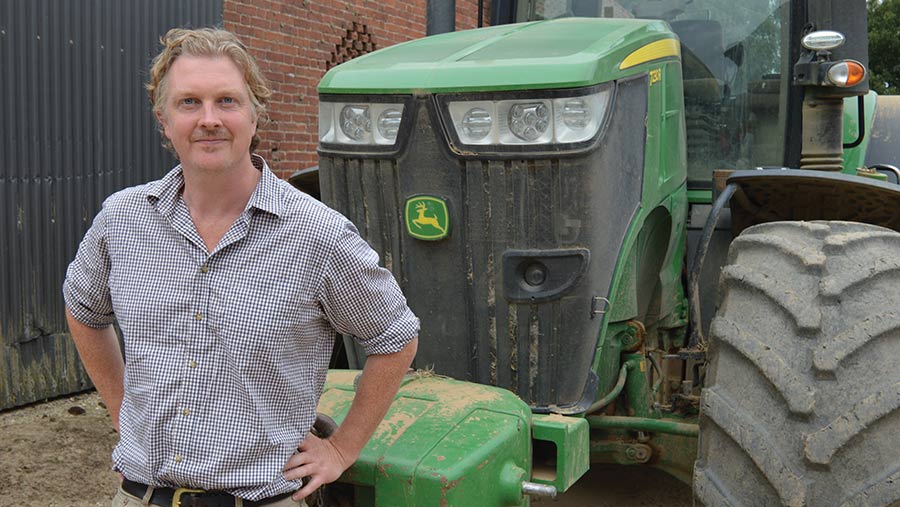No-insecticide wheat yields over 10t/ha for Norfolk grower
 Grouse winter wheat © MAG/David Jones
Grouse winter wheat © MAG/David Jones Norfolk grower Will More is planning a second season of drilling a virus-resistant wheat variety with environmental and financial benefits, while also producing a good yield at harvest 2023.
Using no insecticides and harvesting a yield of 10.7t/ha from the wheat crop grown for seed, and with government support of £45/ha hopefully for this coming season, he says he would grow the variety Grouse on a commercial basis in the future.
The variety is the first winter wheat to combine resistance to the two main pest problems of the crop – aphid-spread barley yellow dwarf virus (BYDV) and orange wheat blossom midge (OWBM) – to give growers the chance of growing wheat without insecticides.
See also: Why it may be time to drop susceptible winter wheat varieties
Will only grows midge-resistant wheats due to problems with this pest on his family farm on the edge of marshland in east Norfolk, and sees resistance to BYDV – a disease which is a concern on the farm – as the next logical move in wheat breeding.
“Grouse is a great start, and I hope the technology can develop as I can see us growing the variety commercially,” he says.

Will More © MAG/David Jones
Midge resistance
Last season, he grew a 5.5ha block of the variety for seed production within the 35ha of seed wheat grown on the farm, while on the rest of his wheat area of 105ha he grows midge-resistant varieties Champion and Gleam.
In autumn 2022, all his wheats were treated with a pyrethroid insecticide to control the aphids which spread BYDV – all except his small area of Grouse.
That saved him about £15/ha by not using a pyrethroid and its cost of application, and in the future it could gain him a further £45/ha in the no insecticide option under the Sustainable Farming Incentive (SFI).
“Grouse is not a panacea, but it could help us in using a diminishing amount of insecticides on the farm,” he says.
Will farms 325ha of mainly arable land as RJ More & Partners at Manor Farm, Tunstall, halfway between Norwich and Great Yarmouth.
One-third of land is heavy organic clay marshland and the rest medium sandy loams, growing winter wheat, winter barley, vining peas, oilseed rape and sugar beet.
Wheat yields
His wheat yields at harvest 2023 ranged between 8.5t/ha on some of the heavy marshland to 12t/ha of the lighter soils, and so the Grouse at 10.7t/ha was above the farm average, and well above the 9.5t/ha farm’s budgeted yield.
The 5.5ha block was grown on the lighter land after a double spring break of sugar beet and vining peas, and drilled in early October 2022 at 165kg/ha following subsoiling and disc cultivation in a minimum tillage regime.
The farm tends to hold back winter wheat drilling until October on the lighter land to allow for control of grassweeds and also reduce BYDV and septoria pressure, while the heavy marshland is drilled earlier.
The crop of Grouse looked good through the autumn, produced not too thick a crop as it is a slow developing variety with a prostrate growth habit, although some septoria was seen to be creeping in.
The nitrogen fertiliser regime was a modest 200kg/ha in a two-way split as the crop followed vining peas, while a relatively robust four-spray fungicide strategy was used to counter disease. The variety showed good tillering and tiller retention in the spring.
Disease threat
Septoria is the main wheat disease threat on the farm, which is low lying and very near the Norfolk coast with sea mists often present, but yellow rust can also be a problem.
He has grown a 10t/ha crop of the first BYDV-resistant wheat variety Wolverine previously, and although both varieties have a similar moderate resistance score against septoria, Grouse shows better resistance to yellow rust.
Harvest was about seven-to-10 days later than normal this summer due to wet weather with the wheat cut from early August onwards with the Grouse combining well.
He is interested in seeing how the variety will perform as a second wheat on the same field with the only difference this coming season likely to be an extra 30kg/ha of nitrogen as a second wheat to bring the rate up to 230kg/ha.
This season, he will be looking to apply for the no insecticide payment of £45/ha under the SFI, which would bring him nearly £250, but if his whole 140ha of wheat was produced with no insecticides it would bring in £6,300.
Top yielder with high BYDV pressure
Grouse outyields other top winter wheat varieties when BYDV pressure is high and no insecticides are used, and is an advance on the first BYDV-resistant wheat, Wolverine, says Lee Bennett, managing director of the breeder of both varieties RAGT.
He adds that there is increased interest from growers and agronomists in not using insecticides, with resistance to pyrethroid insecticides building up and now financial incentives under the SFI not to use them.
The breeder has taken the resistance to orange wheat blossom midge seen in its Skyfall variety, and other popular ones such as Skyscraper, Gleam and Champion, and added the resistance to BYDV seen in Wolverine, to grow what the breeder terms insecticide-free wheat.
In group trials in Ireland where BYDV was present and no insecticides were used, Grouse yielded 106%, ahead of Ireland’s most popular wheat variety Graham at 102% and the UK’s most widely grown variety Dawsum at 99%.
In the UK, where trials were inoculated with BYDV, Grouse outyielded leading varieties such as Champion by 9% and Extase by 19%.
“In situations where BYDV is present and there is no insecticide spraying, then Grouse came out top of the tree,” he says.
Grouse was due to come up for possible inclusion in the AHDB Recommended List (RL) at the end of this year, but was withdrawn by the breeder as the RL does not use insecticide-free trials, so the variety would not stand out from a pack of other wheat varieties.
There is enough seed available of Grouse to take nearly 2% of the commercial C2 seed winter wheat market this autumn.
The variety is seen to have a fungicide-treated yield above Wolverine’s 99% and below Gleam at 103% in the current RL.
Its septoria resistance is seen as similar to Wolverine at 5.9, and yellow rust in the mid-5s better than Wolverine’s 4, and with a slight edge this season over Gleam’s 5 on a 1-9 scale where a high figure indicates that a variety shows the character to a high degree.
Standing power is seen as a 7, similar to Dawsum, Extase, Gleam and Wolverine, stiffer strawed than Champion (6) and Redwald (5), but not as strong as Skyfall (8).
The added cost of the BYDV-resistance gene Bdv2 for Grouse seed is £15/ha, or about the chemical and application cost of one pyrethroid insecticide, and there could well be the need for multiple sprays in a mild open autumn.
“For the cost of one pyrethroid and application cost, growers will get season-long control,” he says.
The BYDV resistance breakthrough came with Wolverine, which was added to the AHDB RL in December 2020
This resistance is seen as a more sustainable way of dealing with the aphid-spread disease, which is exacerbated by milder winters thought to be brought on by climate change, and offers more diversity with no need for insecticides.
